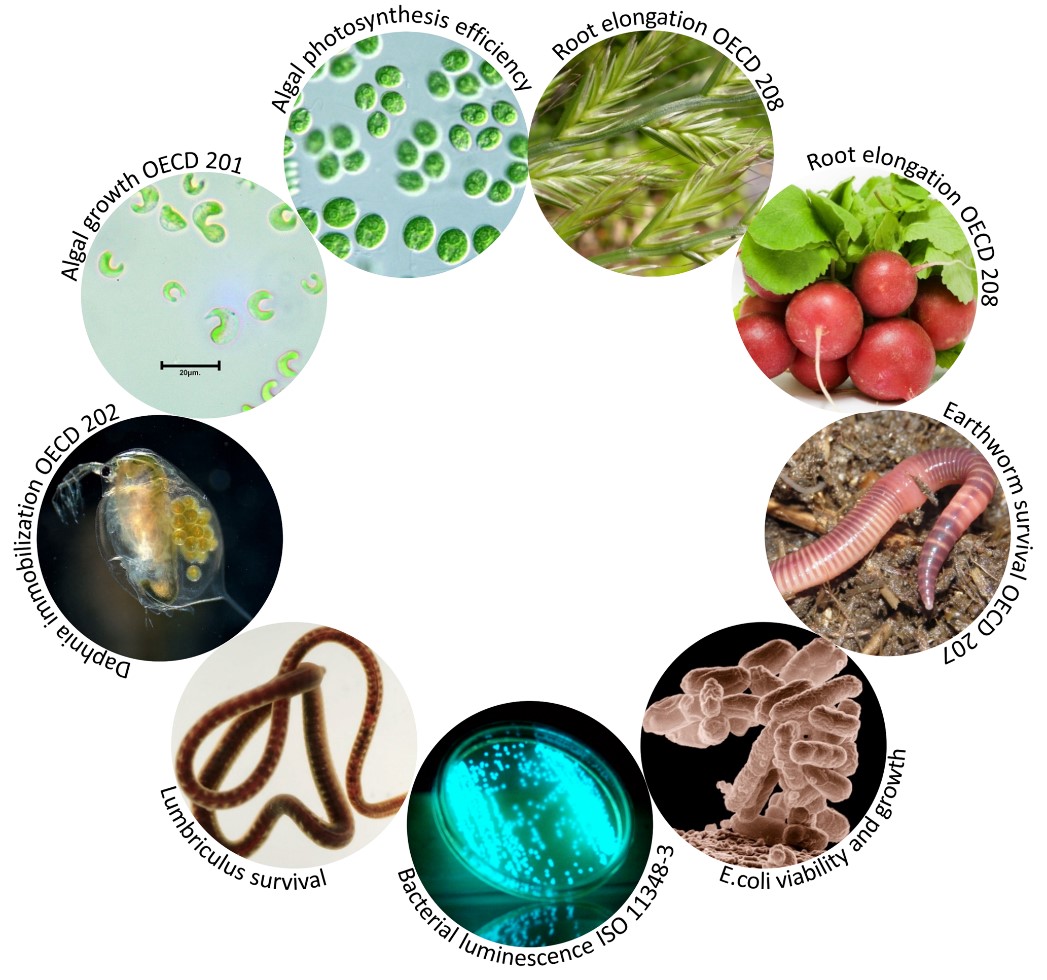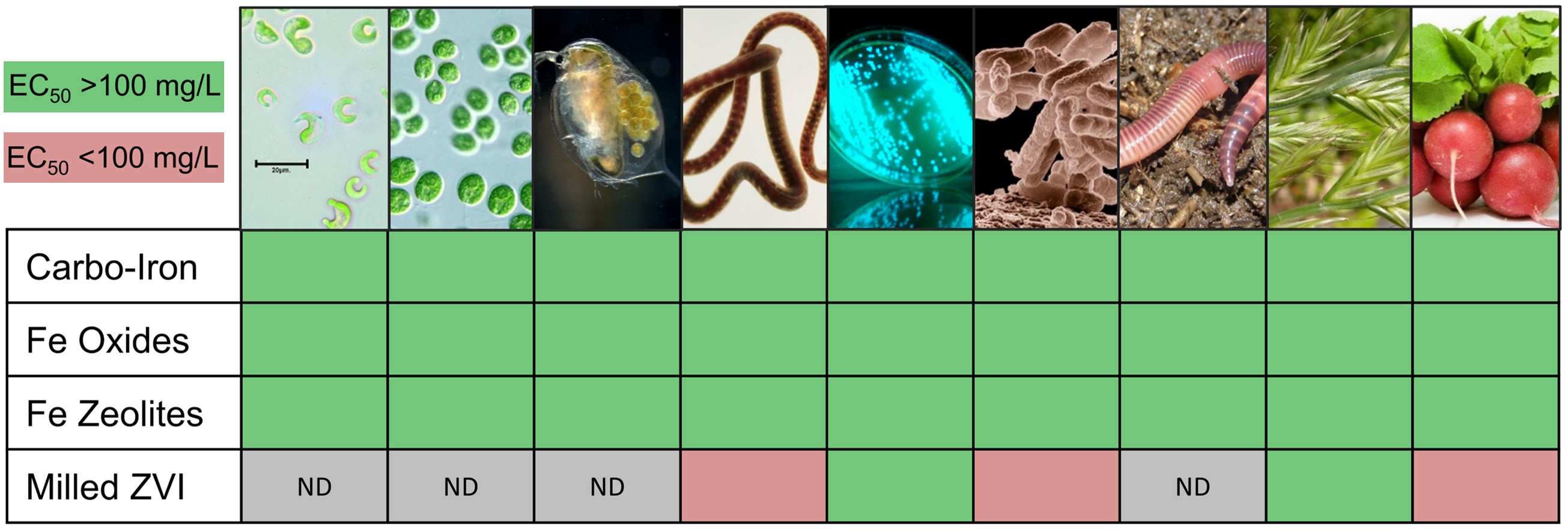WP5 Environmental Impact of Reactive Nanoparticles
|
Objectives
- Assess ecotoxicity of NPs, NP transformation products and pollutant metabolites under laboratory and field conditions, taking into account matrix effects on exposure.
- Describe time-course of ecotoxicity and quantify the potential for toxicity alleviation after migration, oxidation and ageing of NPs in contact with soil.
- Describe NP-microbial interactions during and after remediation with NPs.
|
A major regulatory obstacle for widespread use of nanoparticles in-situ is uncertainty about unintended effects on the environment. Many stakeholders, including NGOs, regulatory authorities, and the general public, have expressed serious concern regarding the effects of unintended release of engineered nanoparticles into the environment. This scepticism is less pronounced when it comes to nZVI, as the transformation products are iron oxides, which are natural soil constituents. Yet, some uncertainties remain and new mobilising agents and particle types (e.g. bi-metallic nanoparticles) need testing to verify or reject claims of possible adverse environmental effects. Two important characteristics determine environmental risks: mobility (transport of nanoparticles to deep layers of surface soil or to surface waters via erosion or recharge from groundwater) and toxicity (the capacity of reactive nanoparticles to cause harm).
In the scientific literature, ecotoxicity has been tested for a wide range of commercially used nanoparticles, and in some cases, low toxicity thresholds have been reported. Data on toxicity of nZVI and related materials are scarce, and more such data is needed. Bacteria are likely to be among the few organisms that will ever come into contact with reactive nanoparticles used for remediation, but for the completeness of NanoRem’s environmental impact assessments, the provision of toxicity thresholds for other organisms used in standardized soil and water tests is needed to cover the widest possible range of scenarios (accidental release, use in media like polluted water, sediments or surface soil). This will also provide a broad range of data that will be useful in future risk assessments. If no toxicity is observed, the broad testing with standard methods (e.g. OECD standard tests) supplemented with test endpoints that provide mechanistic explanations will support the notion that the nanoparticles are sustainable, perform well in treating environmental pollutants, and are inoffensive to the environment.
An additional concern for use of reductive nanoparticles in the subsurface is that they may, at least temporarily, remove biologically available electron acceptors (e.g. SO42-, NO3-) to an extent that arrests indigenous microbial activity and thereby interferes with ecological functions like a sustained microbial denitrification that removes NO3- from groundwater. Investigations of resilience in concerned microbial communities and the duration of effects (likely to be limited) or possibility of restitution (likely to be high) will be conducted.
Ecotoxicological studies in NanoRem are addressing the gaps outlined above and provide important feedback both as a solid internal warning to project partners developing nanoparticles (WP2 and WP3) and risk communication (WP9), and as a broad and solid documentation on hazards destined for stakeholders dealing with risk management and regulatory issues. This is being carried out by:
- Establishing a baseline for potential (maximum) toxicity specific for nanoparticles (with and without coatings) for comparison of materials and for ranking organisms and endpoints (e.g. mortality, growth, reproduction) with respect to sensitivity. NanoRem tests have been based on exposure of terrestrial and aquatic organisms to several types of NP. NanoFer STAR, nano-magnetite, nano-goethite, Fe-zeolite, Carbo-Iron and biogenic nano-magnetite generally showed no negative effects at environmentally relevant concentrations, but occasionally weak effects at high concentrations. The highest toxicity was seen in the presence of milled Fe particles, whereas positive effects on some organisms were observed in the presence of Carbon-Iron.
- Assessing the ecotoxicity of, and exposure to, nanoparticle transformation products and pollutant metabolites in groundwater from lab experiments (WP4, WP8) and field tests (WP10) with nanoparticles. Tests include time-course sampling to assess effects of ageing, and account for the (assumed) reduction in toxicity caused by nanoparticles transformation and adsorption to solid matrices. Data from ecotoxicity tests with nanoparticle-treated groundwater and soil were non-existent prior to NanoRem, and therefore represent a strong innovative aspect of the present project. The impact of this data will be further enhanced when coupled with data on mobility (WP4) and used for risk management (WP9).
- Information on microbial interactions during and after remediation with nanoparticles. This requires characterising the microbial communities in soils and aquifers, prior to, during and after nanoparticle application. Metabolic capacities and rates will be monitored to assess to what extent and with what delay these functions are affected and restored if negatively impacted. Work has begun on providing this information, and results will be available later in the project.

Figure 1: Overview of tests permformed to establish the ecotoxicity of nanoparticles (Hjorth et al. 2015 poster ACS, figure: C. Coutris)

Figure 2: Outcome of the ecotoxicity testing for selected particles. EC50: concentration giving 50% effect (Hjorth et al. 2015 poster ACS, figure: C. Coutris)
|
|
|